Excerpts from Jim Conrad's
Naturalist Newsletter
from the January 23, 2011 Newsletter issued from Hacienda Chichen Resort beside Chichén Itzá Ruins, central Yucatán, MÉXICO; limestone bedrock, elevation ~39m (~128ft), ~N20.676°, ~W88.569°
PURPLE BUSHBEAN
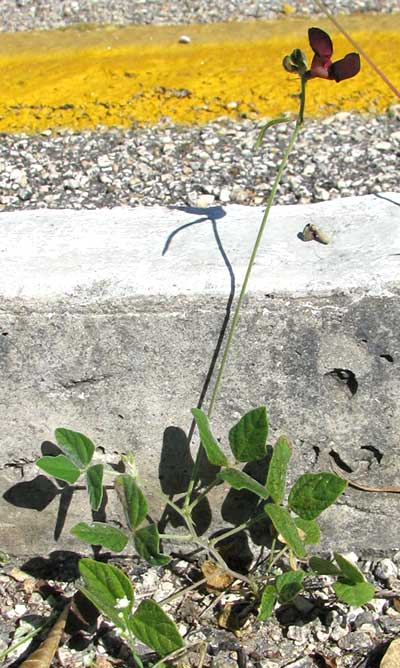
Up where the road north from Pisté intersects with the four-lane Autopista running between Mérida and Cancún, in a weedy, open triangle where three lanes converged, there was a foot-tall plant new to me. It's shown above.
Even before dismounting the bike, because of its trifoliate leaves and bilaterally symmetrical flowers, I knew it was a member of the Bean Family. However, as soon as I sat cross-legged in the traffic triangle examining the flowers I saw that I had something unusual. A side view of a blossom showing one large petal held aloft and another held horizontally is shown below:

To realize how abnormal that blossom is you need to know what "normal" flowers in the Bean Family look like. The butterfly-like, "papilionaceous" flowers of most species of the Bean Family are described at www.backyardnature.net/fl_beans.htm.
On that page "normal" bean flowers are shown to have a large "standard" or "banner" flying over the blossom, two smaller side-petals known as "wings," and a "keel" consisting of two lower petals fused along their common margin to form a boat-like scoop. Garden beans, Redbuds, Honeylocusts, clover, lespedeza -- all have flowers basically structured like this.
Our roadside bean appears to have a fine standard flying above it, but its wings aren't apparent, and instead of having a boat-shaped keel, there's just one flat petal. To understand what was going on I had to view the flower from below and one side. That view is shown below:

It took some mental gymnastics to see it, but finally I realized what's going on. Remembering that that view is from below and to one side, I saw that the wing on the picture's right, instead of meekly staying at the side, flairs upward to do the standard's work. The opposite wing twists so that it forms the horizontal platform held before the flower. The boat-like keel arises in its usual place at the bottom, but forms a slender tube that screws upward and backward into the corolla. The standard, instead of rising conspicuously above the flower, is that large, pinkish thing forming a fleshy flap on the flower's far side.
Looking into the flower from the front you see how the keel turns into a cylinder coiling upward and backward, shown below:
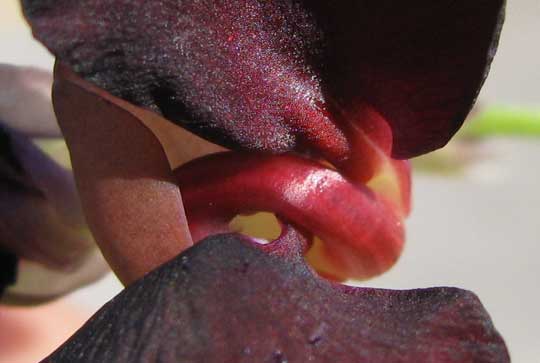
With the lower wing removed we can see how the white, wormlike, stigma-tipped style exits the tubelike keel below:

Why on Earth would a flower screw itself into such a bizarre configuration? I saw the answer when a bee landed on the platform-like lower wing, thrust itself into the blossom forcing petals this way and that, and the wormlike style shot out of the keel-tube to latch onto pollen carried by the visitor. As usual, the screwiness is all for better sex.
One last shot of the plant shows its trifoliate leaf below:
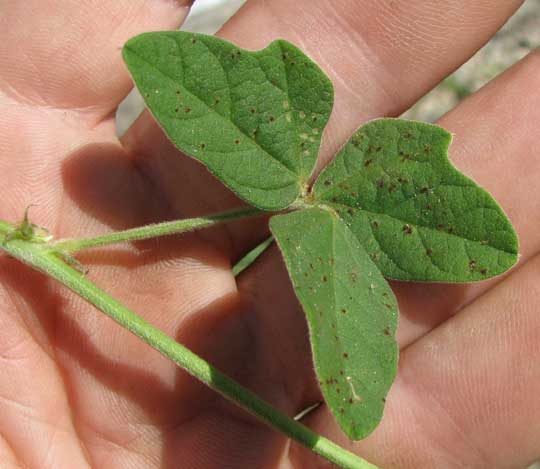
So, the mystery plant is: MACROPTILIUM ATROPURPUREUM, native from Texas through Mexico and the Caribbean through Central America deep into South America, but now naturalized throughout the world's tropics and subtropics. The reason it enjoys such wide distribution is that it's widely cultivated as a forage plant in pastures, and sometimes is planted to control erosion. In fact, I suspect that the latter reason is why it was inside the traffic triangle and nowhere else I've seen. Probably a highway worker threw a handful of seeds into the triangle "for erosion control.
issued on December 1, 2019 from near the forest just west of Tepakán; elev. ~9m (~30 ft), N21.053°, W89.052°; north-central Yucatán state, MÉXICO
A RED-FLOWERED FORM
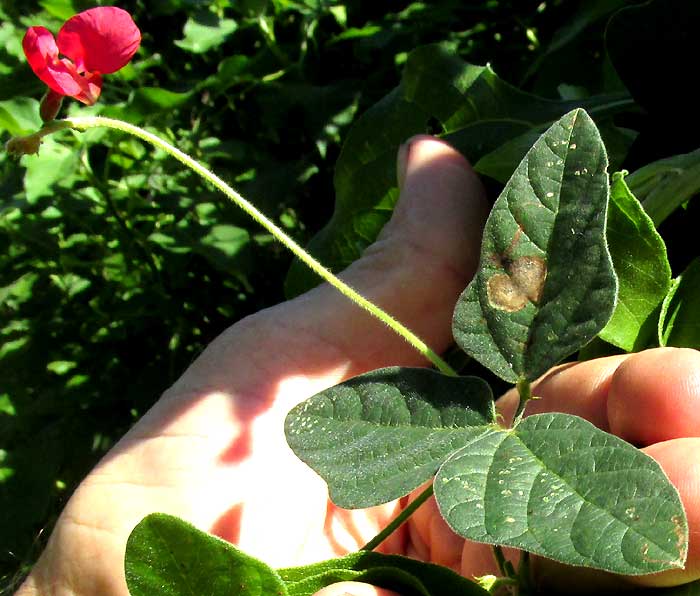
At first it never occurred to me that the above could be the commonly occurring Macroptilium atropurpureum, which has ±black flowers and which I recall as a regular wildflower, not a vine. In the picture, only the somewhat "eared" shape of the leaflets should have cued me to the identity of this red-blossomed vine. Up close, however, a blossom's weird keel -- the two lower petals of a Bean Family's papilionaceous flowers united along their common margin -- looked pure Macroptilium atropurpureum, as shown below:
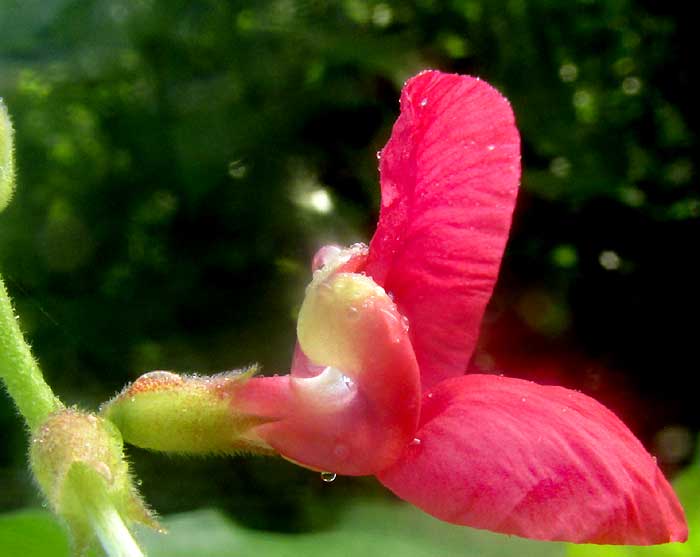
Notice how the keel curves upward and to one side. A frontal view appears below:
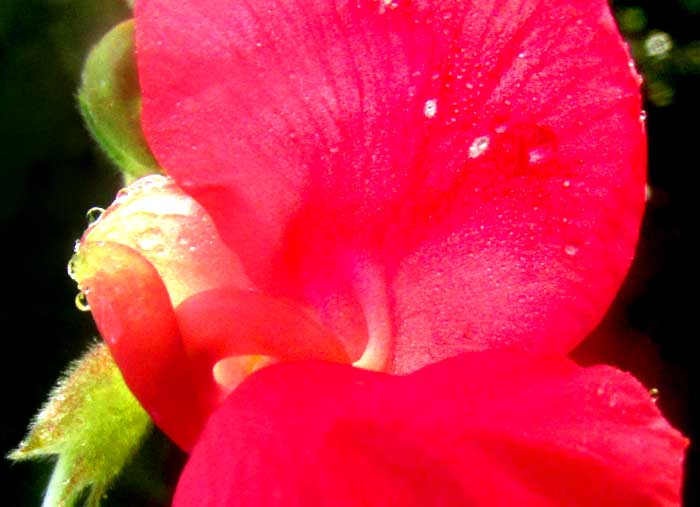
I find no literature admitting to the possibility of red flowers in Macroptilium atropurpureum. However, the plant's white-hairiness, the calyx's tooth lengths, stipule shape and more all are right for Macroptilium atropurpureum. And our own picture of the blackish blossoms of a Yucatan Macroptilium atropurpureum show a slight hue of redness, so that provides confidence for calling this a red-flowered form of that species. Along the rancho's entry road I've seen three populations of the form, but nowhere else.